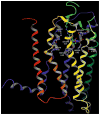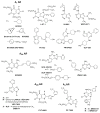Introduction to adenosine receptors as therapeutic targets
- PMID: 19639277
- PMCID: PMC3415694
- DOI: 10.1007/978-3-540-89615-9_1
Introduction to adenosine receptors as therapeutic targets
Abstract
Adenosine acts as a cytoprotective modulator in response to stress to an organ or tissue. Although short-lived in the circulation, it can activate four subtypes of G protein-coupled adenosine receptors (ARs): A(1), A(2A), A(2B), and A(3). The alkylxanthines caffeine and theophylline are the prototypical antagonists of ARs, and their stimulant actions occur primarily through this mechanism. For each of the four AR subtypes, selective agonists and antagonists have been introduced and used to develop new therapeutic drug concepts. ARs are notable among the GPCR family in the number and variety of agonist therapeutic candidates that have been proposed. The selective and potent synthetic AR agonists, which are typically much longer lasting in the body than adenosine, have potential therapeutic applications based on their anti-inflammatory (A(2A) and A(3)), cardioprotective (preconditioning by A(1) and A(3) and postconditioning by A(2B)), cerebroprotective (A(1) and A(3)), and antinociceptive (A(1)) properties. Potent and selective AR antagonists display therapeutic potential as kidney protective (A(1)), antifibrotic (A(2A)), neuroprotective (A(2A)), and antiglaucoma (A(3)) agents. AR agonists for cardiac imaging and positron-emitting AR antagonists are in development for diagnostic applications. Allosteric modulators of A(1) and A(3) ARs have been described. In addition to the use of selective agonists/antagonists as pharmacological tools, mouse strains in which an AR has been genetically deleted have aided in developing novel drug concepts based on the modulation of ARs.
Figures





Similar articles
-
Recent developments in adenosine receptor ligands and their potential as novel drugs.Biochim Biophys Acta. 2011 May;1808(5):1290-308. doi: 10.1016/j.bbamem.2010.12.017. Epub 2010 Dec 23. Biochim Biophys Acta. 2011. PMID: 21185259 Free PMC article. Review.
-
Medicinal Chemistry and Therapeutic Potential of Agonists, Antagonists and Allosteric Modulators of A1 Adenosine Receptor: Current Status and Perspectives.Curr Pharm Des. 2019;25(25):2697-2715. doi: 10.2174/1381612825666190716100509. Curr Pharm Des. 2019. PMID: 31333094 Review.
-
Systemic adenosine given after ischemia protects renal function via A(2a) adenosine receptor activation.Am J Kidney Dis. 2001 Sep;38(3):610-8. doi: 10.1053/ajkd.2001.26888. Am J Kidney Dis. 2001. PMID: 11532695
-
Adenosine receptor ligands-recent developments part I. Agonists.Curr Med Chem. 2000 Dec;7(12):1269-88. doi: 10.2174/0929867003374101. Curr Med Chem. 2000. PMID: 11032971 Review.
-
G protein-coupled adenosine (P1) and P2Y receptors: ligand design and receptor interactions.Purinergic Signal. 2012 Sep;8(3):419-36. doi: 10.1007/s11302-012-9294-7. Epub 2012 Feb 29. Purinergic Signal. 2012. PMID: 22371149 Free PMC article. Review.
Cited by
-
Adenosine A1 Receptors Participate in Excitability Changes after Cortical Epileptic Afterdischarges in Immature Rats.Pharmaceuticals (Basel). 2023 Dec 15;16(12):1733. doi: 10.3390/ph16121733. Pharmaceuticals (Basel). 2023. PMID: 38139859 Free PMC article.
-
CD73 (Cluster of Differentiation 73) and the Differences Between Mice and Humans.Arterioscler Thromb Vasc Biol. 2019 Mar;39(3):339-348. doi: 10.1161/ATVBAHA.118.311579. Arterioscler Thromb Vasc Biol. 2019. PMID: 30676071 Free PMC article. Review.
-
CD39-adenosinergic axis in renal pathophysiology and therapeutics.Purinergic Signal. 2018 Jun;14(2):109-120. doi: 10.1007/s11302-017-9596-x. Epub 2018 Jan 13. Purinergic Signal. 2018. PMID: 29332180 Free PMC article. Review.
-
Design and Rationale for comParison Between ticagreLor and clopidogrEl on mIcrocirculation in Patients with Acute cOronary Syndrome Undergoing Percutaneous Coronary Intervention (PLEIO) Trial.J Cardiovasc Transl Res. 2018 Feb;11(1):42-49. doi: 10.1007/s12265-017-9783-8. Epub 2018 Jan 17. J Cardiovasc Transl Res. 2018. PMID: 29344840 Free PMC article. Clinical Trial.
-
Adenosine Kinase on Deoxyribonucleic Acid Methylation: Adenosine Receptor-Independent Pathway in Cancer Therapy.Front Pharmacol. 2022 Jun 1;13:908882. doi: 10.3389/fphar.2022.908882. eCollection 2022. Front Pharmacol. 2022. PMID: 35721189 Free PMC article. Review.
References
-
- Akaiwa K, Akashi H, Harada H, Sakashita H, Hiromatsu S, Kano T, Aoyagi S. Moderate cerebral venous congestion induces rapid cerebral protection via adenosine A1 receptor activation. Brain Res. 2006;1122:47–55. - PubMed
-
- Arispe N, Ma J, Jacobson KA, Pollard HB. Direct activation of cystic fibrosis transmembrane conductance regulator (CFTR) channels by CPX and DAX. J Biol Chem. 1998;273:5727–5734. - PubMed
-
- Auchampach JA, Jin X, Moore J, Wan TC, Kreckler LM, Ge ZD, Narayanan J, Whalley E, Kiesman W, Ticho B, Smits G, Gross GJ. Comparison of three different A1 adenosine receptor antagonists on infarct size and multiple cycle ischemic preconditioning in anesthetized dogs. J Pharmacol Exp Ther. 2004;308:846–856. - PubMed
-
- Awad AS, Huang L, Ye H, Duong ET, Bolton WK, Linden J, Okusa MD. Adenosine A2A receptor activation attenuates inflammation and injury in diabetic nephropathy. Am J Physiol Renal Physiol. 2006;290:F828–F837. - PubMed
-
- Baraldi PG, Tabrizi MA, Gessi S, Borea PA. Adenosine receptor antagonists: translating medicinal chemistry and pharmacology into clinical utility. Chem Rev. 2008;108:238–263. - PubMed
Publication types
MeSH terms
Substances
Grants and funding
LinkOut - more resources
Full Text Sources
Other Literature Sources
Research Materials

